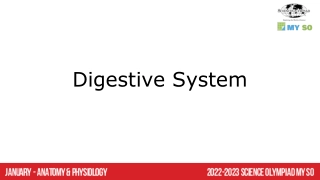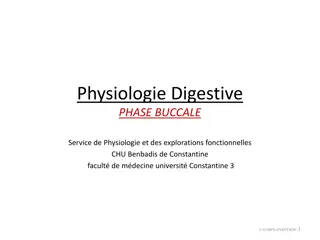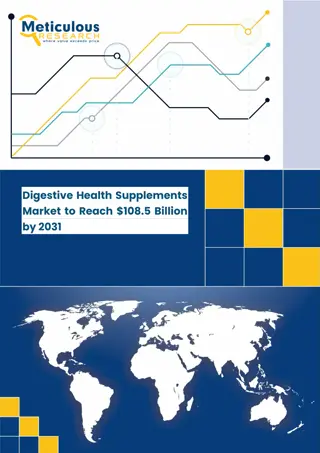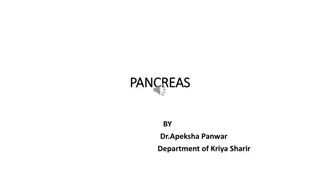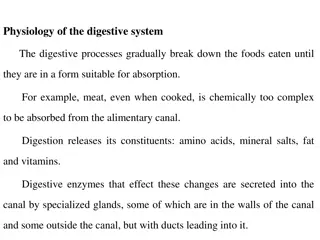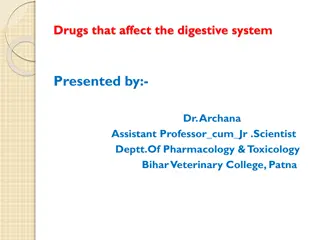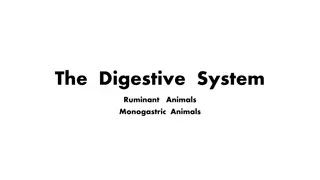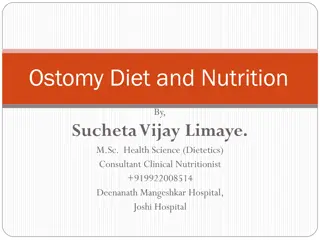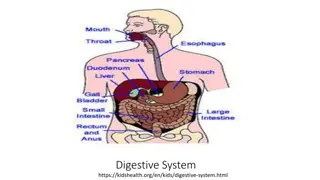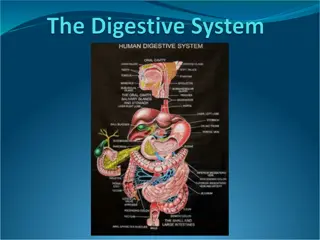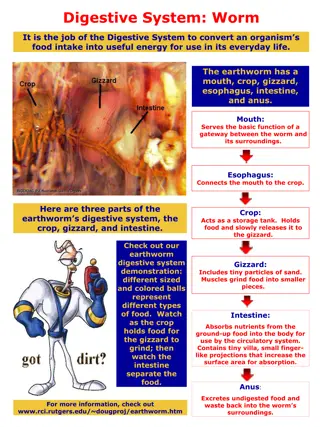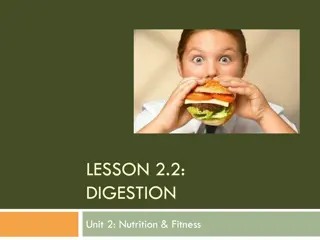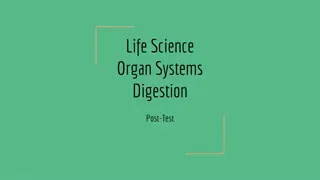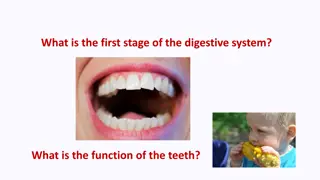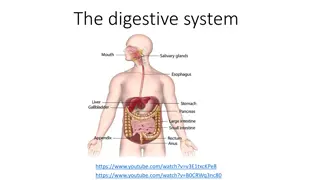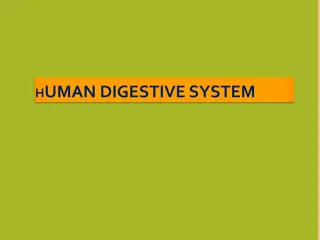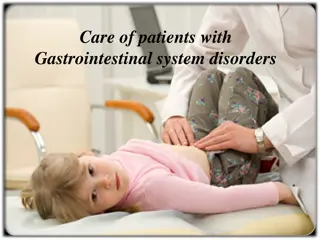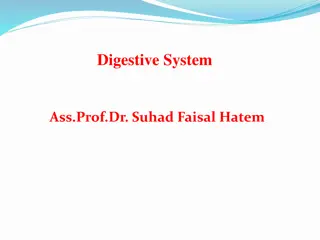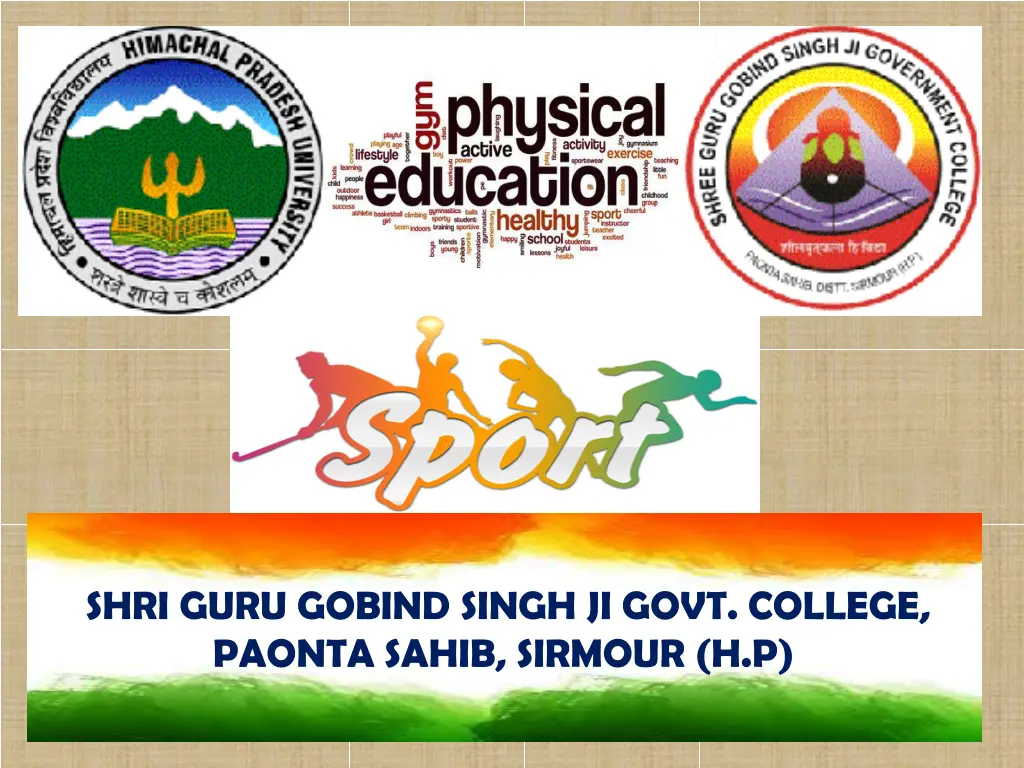
Explore Human Anatomy and Physiology of the Digestive System at Shri Guru Gobind Singh Ji Govt. College
Discover the intricacies of the digestive system in the Human Anatomy and Physiology course at Shri Guru Gobind Singh Ji Govt. College. Uncover the organs involved, from the mouth to the anus, and understand how they work together for digestion and nutrient absorption. Delve into the functions of the mouth, esophagus, stomach, small intestine, pancreas, liver, and more, in this detailed exploration. Learn about the anatomy of the digestive system and enhance your knowledge of this vital bodily process.
Download Presentation

Please find below an Image/Link to download the presentation.
The content on the website is provided AS IS for your information and personal use only. It may not be sold, licensed, or shared on other websites without obtaining consent from the author. If you encounter any issues during the download, it is possible that the publisher has removed the file from their server.
You are allowed to download the files provided on this website for personal or commercial use, subject to the condition that they are used lawfully. All files are the property of their respective owners.
The content on the website is provided AS IS for your information and personal use only. It may not be sold, licensed, or shared on other websites without obtaining consent from the author.
E N D
Presentation Transcript
SHRI GURU GOBIND SINGH JI GOVT. COLLEGE, PAONTA SAHIB, SIRMOUR (H.P)
B.A. 2nd YEAR COURSE NAME: HUMAN ANATOMY AND PHYSIOLOGY COURSE CODE: PED201TH
DIGESTIVE SYSTEM
TOPICS TO BE COVERED DIGESTIVE SYSTEM ORGANS OF DIGESTIVE SYSTEM MOUTH ESOPHAGUS STOMACH SMALL INTESTINE PANCREAS LIVER GALLBLADDER COLON RECTUM ANUS
DIGESTIVE SYSTEM The organs that take in food and liquids and break them down into substances that the body can use for energy, growth, and tissue repair. Waste products the body cannot use leave the body through bowel movements. The digestive system includes the mouth, pharynx (throat), esophagus, stomach, small intestine, large intestine, rectum, and anus. It also includes the salivary glands, liver, gallbladder, and pancreas, which make digestive juices and enzymes that help the body digest food and liquids. Also called gastrointestinal system.
Anatomy of the digestive system. The digestive system is made up of organs that are important for digesting food and liquids. These include the mouth, pharynx (throat), esophagus, stomach, small intestine, large intestine, rectum, and anus. The digestive system also includes the salivary glands, liver, gallbladder, and pancreas, which make digestive juices and enzymes that help with digestion.
ORGANS OF DIGESTIVE SYSTEM The main organs that make up the digestive system (in order of their function) are the mouth, esophagus, stomach, small intestine, large intestine, rectum and anus. Helping them along the way are the pancreas, gall bladder and liver. Here s how these organs work together in your digestive system.
MOUTH The mouth is the beginning of the digestive tract. In fact, digestion starts before you even take a bite. Your salivary glands get active as you see and smell that pasta dish or warm bread. After you start eating, you chew your food into pieces that are more easily digested. Your saliva mixes with the food to begin to break it down into a form your body can absorb and use. When you swallow, your tongue passes the food into your throat and into your esophagus.
ESOPHAGUS Located in your throat near your trachea (windpipe), the esophagus receives food from your mouth when you swallow. The epiglottis is a small flap that folds over your windpipe as you swallow to prevent you from choking (when food goes into your windpipe). A series of muscular contractions within the esophagus called peristalsis delivers food to your stomach. But first a ring-like muscle at the bottom of your esophagus called the lower esophageal sphincter has to relax to let the food in. The sphincter then contracts and prevents the contents of the stomach from flowing back into the esophagus. (When it doesn t and these contents flow back into the esophagus, you may experience acid reflux or heartburn.)
STOMACH The stomach is a hollow organ, or "container," that holds food while it is being mixed with stomach enzymes. These enzymes continue the process of breaking down food into a usable form. Cells in the lining of your stomach secrete a strong acid and powerful enzymes that are responsible for the breakdown process. When the contents of the stomach are processed enough, they re released into the small intestine.
SMALL INTESTINE Made up of three segments the duodenum, jejunum, and ileum the small intestine is a 22-foot long muscular tube that breaks down food using enzymes released by the pancreas and bile from the liver. Peristalsis also works in this organ, moving food through and mixing it with digestive juices from the pancreas and liver. The duodenum is the first segment of the small intestine. It s largely responsible for the continuous breaking-down process. The jejunum and ileum lower in the intestine are mainly responsible for the absorption of nutrients into the bloodstream. Contents of the small intestine start out semi-solid and end in a liquid form after passing through the organ. Water, bile, enzymes and mucus contribute to the change in consistency. Once the nutrients have been absorbed and the leftover-food residue liquid has passed through the small intestine, it then moves on to the large intestine (colon).
PANCREAS The pancreas secretes digestive enzymes into the duodenum that break down protein, fats and carbohydrates. The pancreas also makes insulin, passing it directly into the bloodstream. Insulin is the chief hormone in your body for metabolizing sugar.
LIVER The liver has many functions, but its main job within the digestive system is to process the nutrients absorbed from the small intestine. Bile from the liver secreted into the small intestine also plays an important role in digesting fat and some vitamins. The liver is your body's chemical "factory." It takes the raw materials absorbed by the intestine and makes all the various chemicals your body needs to function. The liver also detoxifies potentially harmful chemicals. It breaks down and secretes many drugs that can be toxic to your body.
GALLBLADDER The gallbladder stores and concentrates bile from the liver, and then releases it into the duodenum in the small intestine to help absorb and digest fats.
COLON The colon is responsible for processing waste so that emptying your bowels is easy and convenient. It s a 6-foot long muscular tube that connects the small intestine to the rectum. The colon is made up of the cecum, the ascending (right) colon, the transverse (across) colon, the descending (left) colon, and the sigmoid colon, which connects to the rectum. Stool, or waste left over from the digestive process, is passed through the colon by means of peristalsis, first in a liquid state and ultimately in a solid form. As stool passes through the colon, water is removed. Stool is stored in the sigmoid (S-shaped) colon until a "mass movement" empties it into the rectum once or twice a day. It normally takes about 36 hours for stool to get through the colon. The stool itself is mostly food debris and bacteria. These good bacteria perform several useful functions, such as synthesizing various vitamins, processing waste products and food particles and protecting against harmful bacteria. When the descending colon becomes full of stool, or feces, it empties its contents into the rectum to begin the process of elimination (a bowel movement).
RECTUM The rectum is a straight, 8-inch chamber that connects the colon to the anus. The rectum's job is to receive stool from the colon, let you know that there is stool to be evacuated (pooped out) and to hold the stool until evacuation happens. When anything (gas or stool) comes into the rectum, sensors send a message to the brain. The brain then decides if the rectal contents can be released or not. If they can, the sphincters relax and the rectum contracts, disposing its contents. If the contents cannot be disposed, the sphincter contracts and the rectum accommodates so that the sensation temporarily goes away.
ANUS The anus is the last part of the digestive tract. It is a 2-inch long canal consisting of the pelvic floor muscles and the two anal sphincters (internal and external). The lining of the upper anus is able to detect rectal contents. It lets you know whether the contents are liquid, gas or solid. The anus is surrounded by sphincter muscles that are important in allowing control of stool. The pelvic floor muscle creates an angle between the rectum and the anus that stops stool from coming out when it s not supposed to. The internal sphincter is always tight, except when stool enters the rectum. This keeps us continent (prevents us from pooping involuntarily) when we are asleep or otherwise unaware of the presence of stool. When we get an urge to go to the bathroom, we rely on our external sphincter to hold the stool until reaching a toilet, where it then relaxes to release the contents.

